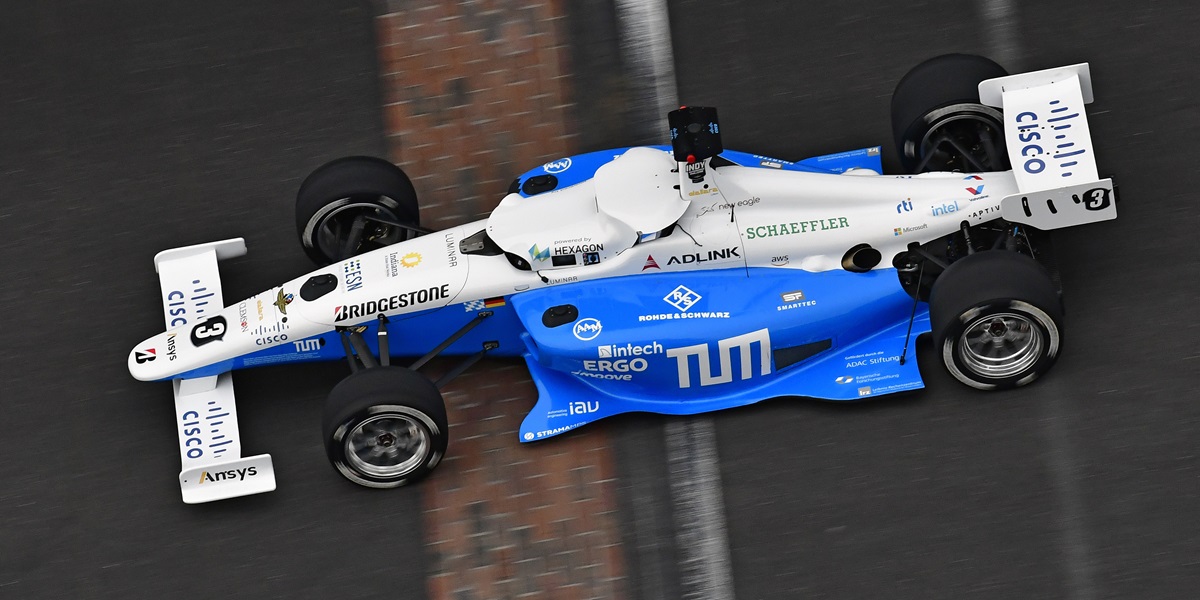
Boundaries Pushed: German Team Wins Indy Autonomous Challenge
October 25, 2021 | By Zach Horrall
The Indianapolis Motor Speedway last weekend harkened back to its roots as a proving ground for the burgeoning automotive industry a century ago as it helped to advance vehicle technology through the Indy Autonomous Challenge on the famed 2.5-mile oval.
For the last two years, 21 universities from around the globe formed nine teams to compete in an autonomous race car competition Saturday, Oct. 23 at the Racing Capital of the World. The car fielded by TUM Autonomous Motorsport, a team made up of students from Technische Universität München in Germany, produced the best two-lap average speed in the final round to win the $1 million prize.
The goal of the event was to further the advancement of technology that can improve the commercialization of advanced driver-assistance systems (ADAS), which increase the safety of driving a passenger vehicle, as well as speed up the commercialization of fully autonomous vehicles.
Examples of ADAS features in passenger cars include adaptive cruise control, anti-lock brakes, traction control, lane departure warning and many more aids that make driving passenger cars safer and easier.
Automotive, engineering, tech and many more industries are going to see tangible results from the nine-car autonomous competition that took place at IMS this year.
“We’re going to see leapfrog improvements in sensor fusion, in low-latency decision making, that are all key to the commercialization of autonomous vehicles, which we know is critical for society from an efficiency standpoint and from an environmental standpoint,” said Paul Mitchell, president and CEO of Energy Systems Network. “And particularly from the standpoint of saving lives, because these advances, ADAS systems, are really critical to reducing driver fatalities.”
It was just another step in the long history of innovation at IMS. It harkened back to the original purpose of the Speedway when it was built in 1909: to build an automobile testing ground to support Indiana’s growing automotive industry.
The facility was used to develop so many areas related and unrelated to motorsports. A.G. Chapple won the first motorized race at IMS, a motorcycle race on Aug. 14, 1909. That fall, the facility was paved with 3.2 million bricks after a crushed stone and tar driving surface didn't work. It was later paved with asphalt. The Wright Brothers participated in the National Aviation Meet at IMS June 13-18, 1910.
Ray Harroun brought the rearview mirror to life in the inaugural Indianapolis 500 in 1911. In 1935, safety-warning lights and helmet use found their way to the Speedway. And SAFER Barriers were introduced to motorsports in 2002 at IMS.
That list doesn’t include specific engine development, diesel technology, turbine engines, aerodynamic technology and much more that were developed during the Indianapolis 500-Mile Race.
“We think the Indianapolis Motor Speedway is a pretty special place, and I think for any race fan on the planet it’s a special place, but the activities here under the Indy Autonomous Challenge are truly incredible,” said Mark Miles, president and CEO of Penske Entertainment Corp. “This is on a whole new order of magnitude. The degree of difficulty here is extraordinary.”
Mitchell also was a co-organizer of the Indy Autonomous Challenge and said the purpose of the event was to advance state-of-the-art technology. In his experience, one of the best ways to do that is through prize competitions like this event.
Indianapolis-based Lilly Endowment Inc. provided a grant to help fund the $1 million prize that went to the team with the best two-lap average speed. While nine cars were entered in the competition, which was reminiscent of Indianapolis 500 qualifying, not all teams were able to make runs due to the challenging nature of the event.
With a two-lap average speed of 135.944 mph, TUM Autonomous Motorsports set the record for the best two-lap average speed in autonomous oval racing competition. The team said the prize money will go toward fundraising for more projects that will spur innovation in the autonomous vehicle industry.
Meanwhile, EuroRacing, a team made up of students from Italy, Switzerland and Poland, recorded the fastest one-lap speed in autonomous oval racing competition, 139.009 mph.
The single-car runs produced average speeds that were not seen in Indianapolis 500 qualifying until the 1950s. In 1951, Duke Nalon won the pole for the Indianapolis 500 with a four-lap average speed of 136.498 mph. In 1950, Walt Faulkner won the pole with an average speed of 134.343 mph, slower than the two-lap average speed produced by TUM Autonomous Motorsports.
It was a record-breaking and monumental weekend in Indianapolis, and one that Miles believes will take time for society to understand and appreciate what exactly was learned, innovated and applied. But years down the road, when passenger cars contain yet another feature that was developed at the Indianapolis Motor Speedway, the Indy Autonomous Challenge will live on.
“Like all innovation, I don’t think we know what this is going to mean,” Miles said. “Time will tell. We’re very proud that it’s taking place here.”